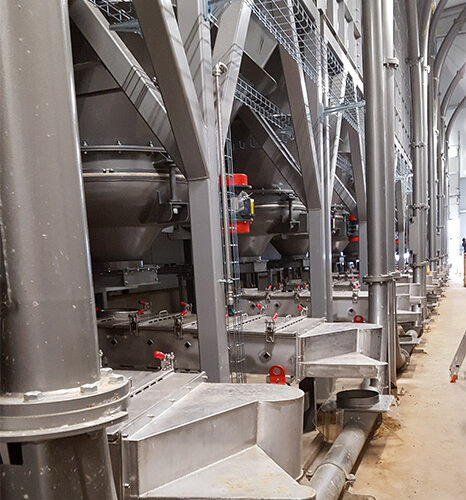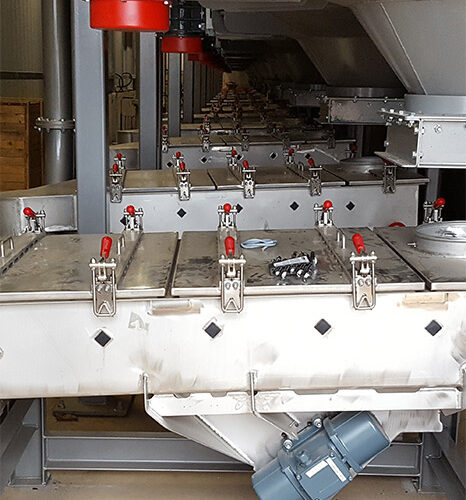The customer is specialised in the production of high-quality dry food for dogs and cats. The branded products are established throughout the EU in retail, discounters or specialised markets and are mainly sold as pellets.
Pet food pellets are popular because they have many advantages for mistresses, masters and four-legged friends: good feed intake, easy handling, no segregation of the feed ingredients, good flowability. And they are largely dust-free. The higher bulk density also saves storage and transport capacity. And that makes the manufacturer happy.
The company produces so-called extrudates according to various recipes, which are then pressed into pellets and, in one product case, subsequently coated. At the beginning of the continuous production process, all raw materials are crushed and mixed according to the recipe. The dry mixtures follow an optimal particle size distribution. This is crucial for the appearance and, above all, the digestibility of the animal feed.
Coming from the mixer, the feed mixture is pressed into shape in a pellet press. Some pellet variants are also coated after pressing, e.g. with vitamins. After that, dust is removed. Coming from the press, the finished pellets are conveyed to the packaging in up to 14 lines. In each line, the pellets are first stored in storage bins or silos. A screening stage should be integrated between the storage bins and the respective packing station for pellet dedusting.

Suitable for continuous operation
Throughput rate of 10-12 t/h and line
Two pellet sizes: 2 mm for cat food, 5 mm for dog food
Gentle on the product – no damage of coated pellets
Ensuring a high degree of separation for fine particles or dust
Quick screen exchange for changing batches or products
Economical in purchase and operation
High-quality animal feed: production lines for pellet production. For those responsible for the project at the feed manufacturer, the screening solution had to meet a number of requirements.
The company Baumgarten Silo- und Anlagentechnik GmbH in Porta Westfalica was commissioned with the planning and realisation of this process section.
As a bulk solids specialist with over 100 years of experience, Baumgarten offers a wide range of components for handling of bulk solids. In addition to the screening machines, Baumgarten’s conveyors, sliders and extraction units were also used for this project.
Baumgarten designed a part of the plant environment. The engineers worked out a process proposal for the integration of a screening stage. Since a conveying distance of approx. 2 m had to be bridged between the feed hopper and the pipe chain conveyor in each of the 14 lines, the screening machines used had to be fitted in such a way that they also function as a conveying organ.
The screening machines were positioned directly under the outlets of the storage bins and are fed with the pellets by opening a gate valve. After the fine particles have been separated via the screens, the dedusted pellets are fed to several screening chutes as good material with the help of a pipe chain conveyor. In this case, these take over the function of a dosing device before the final packing. The material feed or the dosing rate can be adjusted via the vibration amplitude of the vibration motor on the sieve chutes so that a sufficient quantity of pellets is always available for the packaging process.
Particularly critical for Baumgarten was the selection of the optimal screening process as well as a competent partner for the supply and subsequent support of the screening solution. The choice fell on Engelsmann. We, too, can look back on a tradition in the bulk solids industry that goes back well over a hundred years. Our linear stroke screening machines, vibration and centrifugal screening solutions cover almost all screening processes. In our own technical centre, these processes can be tested live with different products. An opportunity that Baumgarten also took advantage of. Tests were carried out with different screening machines and results were compared.
In the end, the choice fell on the JEL EasyVib vibration screening machine.
With its favourable purchase price and simple handling, the vibration screening machine is unbeatable when economical machine use is a priority for plant operators – without compromising on quality, reliability or the screening result.
The JEL EasyVib is made of stainless steel for animal feed production. All parts can be dismantled for cleaning and maintenance without tools. The clamping system on the housing cover is quickly opened and the interior of the screening machine is then easily accessible. Particularly smooth surfaces prevent unwanted accumulations of product residues. The high-quality tensioning screen mesh can be easily removed and replaced after opening the retaining device upwards.

14 x gentle sieving: The JEL EasyVib vibration screening machine ensures 1a screening results for fine separation in animal feed production.
In addition, the JEL EasyVib has an inclination adjustment for the screen deck and various setting options for the two vibration motors and the vibration amplitude. This allows the screening machine to be adapted to different product properties or screening materials. Although vibration screening machines are not necessarily among the most gentle screening processes for the product, the people responsible at the Engelsmann technical centre found a screening machine setting through the combination of a particularly flat vibration amplitude and a certain layer height of the product on the screen mesh, in which the feed pellets glide gently over the screen mesh while the fine fractions are separated.
The screening surface of the JEL EasyVib in this case was 1.125 m² and the tests in the pilot plant resulted in a throughput of 10 tonnes per machine. The desired degree of separation of the fines could also be achieved. The screening trough is completely closed so that there are no dust emissions during the screening process. The maintenance effort is reduced to a minimum thanks to the low number of wearing parts and the low spare parts prices.
However, the vibration screening machine in the largest standard series was too short for the 2m conveying distance to be covered, so the Engelsmann engineers designed an extended version that could then be fitted exactly between the feed hopper and the tube chain conveyor. Wear-resistant, flexible V-collars were fitted to the inlets and outlets of the JEL EasyVib, via which the screening machine is connected in a dust-tight manner to the gate valves of the feed hopper or, on the outlet side, to the tube chain conveyor.
Conclusion
The special challenge in this project was that a high throughput capacity and an optimum separation efficiency had to be realised at the lowest possible investment and operating costs.
The profound process knowledge of Baumgarten and the customer, combined with the screening technology know-how of Engelsmann, lead to success and a suitable solution could be developed for the given task.
Optimal tuned screening technology not only delivers the desired screening result, it is also neatly integrated into the operator’s plant environment and works reliably and with minimal plant downtimes, especially in continuous production processes.
Ideally, different processes can be tested and compared on a small scale during the solution finding process. The knowledge and process parameters gained in this way can then be scaled to the entire plant, giving the operator more process reliability.
The different properties of products – especially with regard to flowability – have a great influence on the screening result. In order to achieve a specified throughput even for materials with unfavourable screening behaviour, the JEL EasyVib can be quickly adapted to the respective product by regulating the screen inclination, vibration amplitude and the adjustment angle of the vibration motors. Engelsmann is also flexible when it comes to positioning the inlets and outlets of the screening machine – the vibration screening machine is customised to fit into the respective plant environment.

